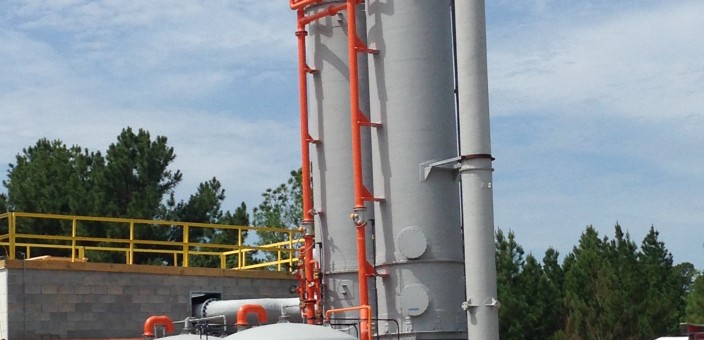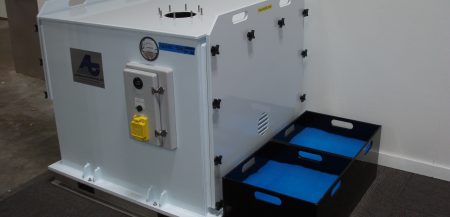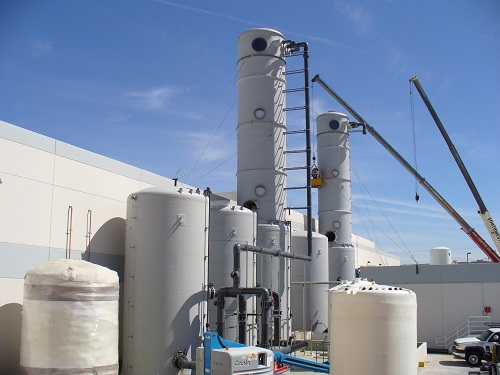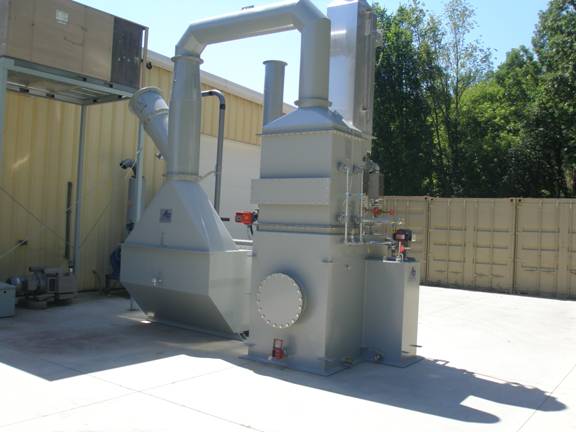PROBLEM
A worldwide specialties chemical manufacturer uses Phosgene (COCl2) in the production of fire retardants. A new Phosgene storage and delivery facility that was in the planning stage would require state-of-the-art containment and ventilation systems due to the extremely toxic nature of this chemical (Immediately Dangerous to Life and Health, IDLH, concentration is only 2 ppmv). Two major areas requiring ventilation were the cylinder storage room and cylinder glove boxes. The air exhausted from these areas would need scrubbing, since it might under typical circumstances contain low levels of Phosgene. The air scrubber system, however, would also have to be capable of handling a catastrophic release of Phosgene. The worst reasonably probable scenario was determined to be 2500 lbs. of Phosgene leaking from a ½ in. sheared pipe
at a rate of 290 lbs./minute. The ventilation rate was determined to be 4000 cfm, so that in event of the catastrophic leak the concentration of Phosgene entering the air scrubber system would be 250,000 ppmv. Besides the air scrubber system having to be low-maintenance, reliable, and cost-effective, it would also have some additional challenges. It would use Sodium Hydroxide (NaOH) to neutralize the Phosgene, a process which generates a large amount of heat; it would have to be able to deliver NaOH fast enough to react with 290 lbs./minute of Phosgene, and have enough NaOH available to react with the full 2500 lbs. of Phosgene; lastly, the air scrubber system would have to operate at an extremely high removal efficiency of 99.9996%, taking the 250,000 ppmv of Phosgene down to 1 ppmv (½ IDLH).
Besides the air scrubber system having to be low-maintenance, reliable, and cost-effective, it would also have some additional challenges. It would use Sodium Hydroxide (NaOH) to neutralize the Phosgene, a process which generates a large amount of heat; it would have to be able to deliver NaOH fast enough to react with 290 lbs./minute of Phosgene, and have enough NaOH
available to react with the full 2500 lbs. of Phosgene; lastly, the air scrubber system would have to operate at an extremely high removal efficiency of 99.9996%, taking the 250,000 ppmv of Phosgene down to 1 ppmv (½ IDLH).
SOLUTION
AAT was awarded the contract to provide the Phosgene air scrubber system based on their submitted design and quotation. Their design was based on analysis and scale-up of data from a recent pilot study conducted by the U.S. Army. This resulted in (2) 30 ft. tall packed towers operated in series. During normal operation, both towers would receive 350 gpm of pH-adjusted water from a 3000 gallon recirculation tank (Tank #1). Recirculation water would be dosed with 20% NaOH for maintaining the water in the tank at pH = 10. In event of a Phosgene leak, a second standby 3000 gallon tank (Tank #2) and pump would deliver an additional 350 gpm of 20% NaOH to both towers. To accommodate doubling the liquid flow, both towers utilized trough style liquid distributors with dual liquid inlets.
Both air scrubber towers were designed to drain back to Tank #1, so that the excess liquid from the Tank #2 pump during an emergency would overflow from Tank #1 to Tank #2. This effectively doubled the mass of liquid in the system, providing adequate heat sink to safely dissipate the Heat of Reaction. The system also would then contain more than enough NaOH to neutralize the full 2500 lbs. of Phosgene. Another interesting aspect of the air scrubber system design was that it would take 10 seconds for the 20% NaOH in Tank #2 to wet the entire height of packing in each tower. This governed the size of continuously operating Tank #1, requiring that it hold enough water at pH = 10 to neutralize the Phosgene coming through during that first 10 seconds.
The Phosgene air scrubber system was installed and started up in the fall of 2014. The system consisted of twin elevated towers on a steel platform, recirculation pumps, PP-lined FRP piping, (2) 3000 gallon FRP liquid recirculation tanks, connecting duct, exhaust fan, 50 ft. tall FRP exhaust stack, full complement of instrumentation, and control panel.






